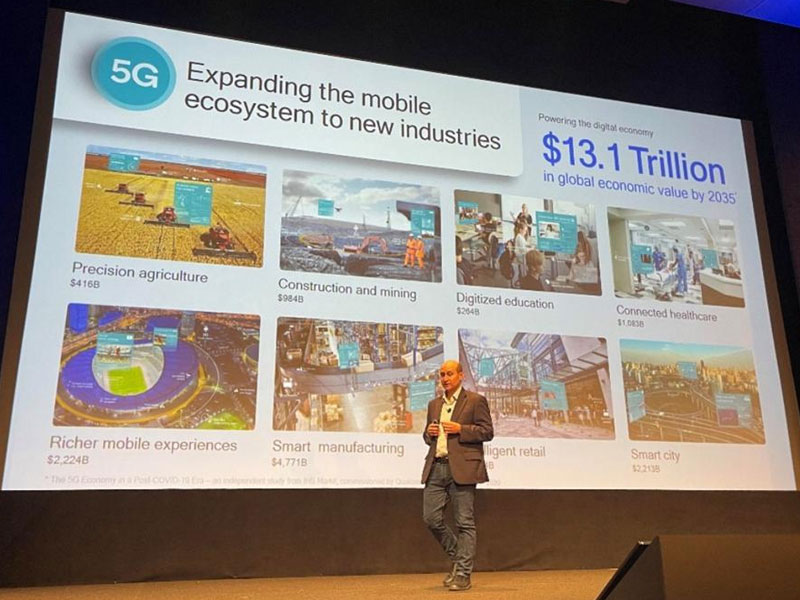Digital twins on the manufacturing menu – with help from the hyperscalers
SOURCE: HTTPS://WWW.IOTTECHNEWS.COM/
NOV 16, 2023
Qualcomm’s quest to make cities smarter
SOURCE: FORBES.COM
OCT 06, 2021

Qualcomm's Durga Malladi, SVP and GM of 5G and Mobile Broadband Infrastructure.
Moor Insights & Strategy
Fellow analyst Anshel Sag and I recently attended our first in-person event together since the beginning of the pandemic—Qualcomm’s Smart Cities Accelerate 2021, hosted at the technology giant’s headquarters in beautiful San Diego, California. Qualcomm’s packed agenda included keynotes, panel discussions and partner presentations. Mr. Sag and I would like to provide our impressions of the event.
A smart city can mean different things to different people, but when we say “smart,” we’re describing any device that leverages connectivity to derive insights and make actionable changes at the edge. A smart city, for example, might leverage connected devices to improve public safety, more accurately meter public utilities, provide enhanced transportation and logistics support, manage waste more efficiently, etc.
Requirements vary widely from city to city, and one size does not fit all. This much was evident in a virtual discussion with mayors Sam Liccardo of San Jose, Francis Suarez of Miami and Tishaura Jones of St Louis. The discussion was moderated by Giorgio Burciaga from Ignite Cities, an organization that is helping each of the municipalities scope out its smart city deployments. One common thread was the discussion around extending connectivity to underserved areas via Wi-Fi and private 5G networks. Mayor Suarez of Miami sees CBRS as a potential game-changer—his city is exploring the deployment of 5G for a host of use cases, including an initiative to digitize public services such as vehicle registration. Mayor Suarez also expressed his interest in the upcoming CBAND 5G spectrum and mused on what the 6G future may hold. CBRS seeks to democratize access to licensed spectrum for cities such as Miami. I have written about the initiative in the past—if interested, you can find that article here.
It’s no secret that Qualcomm is driving the overall 5G ecosystem, thanks in large part to having its own R&D in the 5G standards space with 3GPP. Its portfolio includes industry-leading modems, RF-Front End and its class-leading system on a chip (SOC) design. In the past, the company has also supported numerous OEM customers with reference designs. Qualcomm’s three-year journey with smart cities, however, has taken its reference design efforts even further. Mr. Sag and I learned that the Smart City Accelerate program now includes over 400 partners and delivers end-to-end IoT solutions across more than thirty verticals.
The platform itself is impressive in that it employs a low to no code approach for configuration. It is built on an open API architecture, which facilitates modular widgets for an intuitive user interface. This is an impressive feat given the fragmented IoT industry’s historical lack of standards and its myriad of competing connectivity modalities (Wi-Fi, Bluetooth Low Energy (BLE), LTE, 5G and LoRaWAN). This holistic end-to-end approach creates a pull for Qualcomm silicon, but its failed acquisition of NXP could also point to a change in strategy for smart city solutions. Qualcomm, in the end, wants to deliver a complete solution to municipalities rather than just trying to sell them on a specific piece of hardware or platform. The company assured us that while most of its hardware offerings are Qualcomm-based, but it has some solutions that are not. Qualcomm emphasized its willingness to do the work to qualify and integrate any devices and APIs that a municipality might need.
I was particularly struck by a bold statement Qualcomm CEO Cristiano Amon made during the opening keynote/ panel. Many cities need trusted advisors concerning the evaluation of technology. Mr. Amon desires to position Qualcomm as a CTO to mayors and city governments domestically and worldwide to help them sort through communication infrastructure requirements and deployment strategies. It is decidedly a partnership versus vendor strategy ensuring that Qualcomm, its smart city partner ecosystem, and cities all have equal skin in the game. Key to this strategy is Qualcomm’s desire to deliver a continuous, evergreen solution that is technology agnostic so that cities don’t have to worry about what follows 5G. From my perspective, this path provides exceptional investment protection while avoiding the headaches that come with ripping and replacing infrastructure.
Qualcomm shared a compelling statistic for the naysayers that think 5G isn’t a big deal. The company believes that 5G could have a staggering $13B impact within the next fifteen years and based on what Mr. Sag and I learned at the event, smart cities could be a huge contributor. The event concluded with a compelling command center demonstration that highlighted several use cases Qualcomm deploys on its campus: smart parking, building energy management, security, shuttle service, outdoor monitoring, asset tracking, waste management, a digital twin simulator powered by lidar and employee collaboration. I love the fact that Qualcomm is using its smart city platform to manage its headquarters operations—it was a great exclamation point at the end of an exciting event.
LATEST NEWS
WHAT'S TRENDING


Data Science
5 Imaginative Data Science Projects That Can Make Your Portfolio Stand Out
OCT 05, 2022

SOURCE: HTTPS://WWW.IOTTECHNEWS.COM/
NOV 16, 2023
SOURCE: HTTPS://AITHORITY.COM/
OCT 03, 2023
SOURCE: HTTPS://WWW.SCIENCEDAILY.COM/
AUG 08, 2023
SOURCE: HTTPS://WWW.GLOBALLOGIC.COM
JUL 06, 2023
SOURCE: HTTPS://INDIAAI.GOV.IN/ARTICLE/HOW-DIGITAL-TWIN-TECHNOLOGY-WILL-EVOLVE-IN-2023
JUL 04, 2023
SOURCE: HTTPS://WWW.CNBC.COM/2023/01/21/DIGITAL-TWINS-ARE-SET-FOR-RAPID-ADOPTION-IN-2023.HTML
JUN 30, 2023